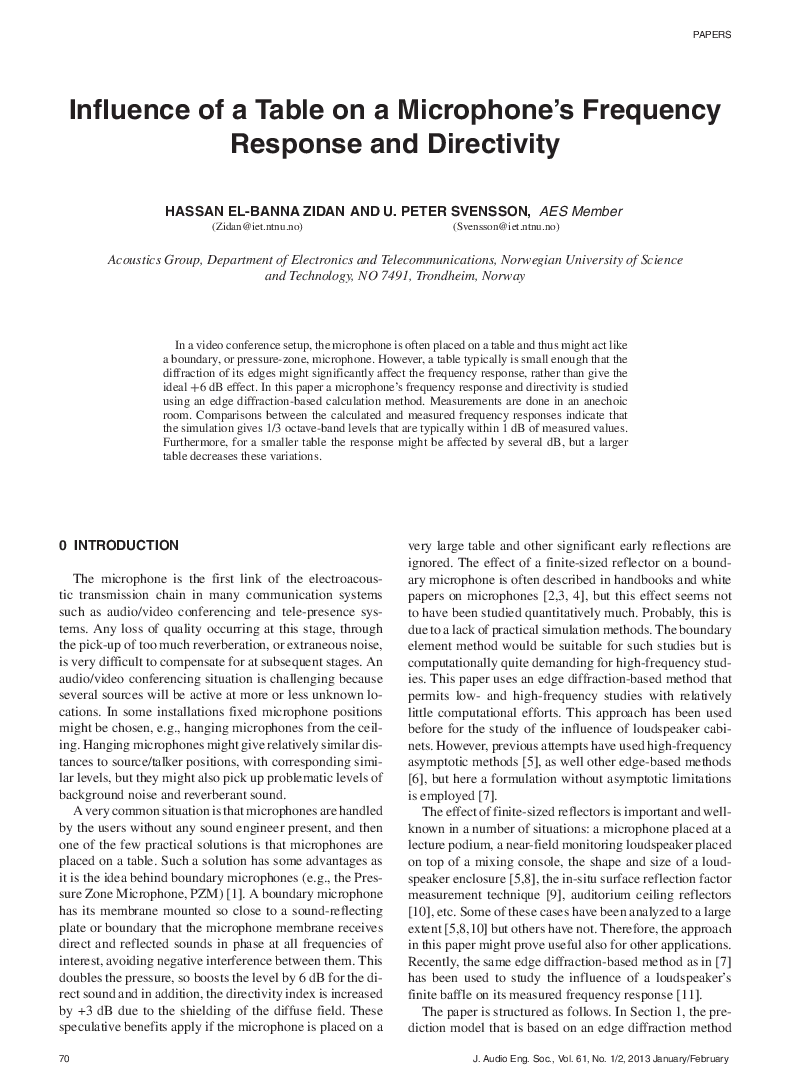Home / Publications / E-library page
You are currently logged in as an
Institutional Subscriber.
If you would like to logout,
please click on the button below.
Home / Publications / E-library page
Only AES members and Institutional Journal Subscribers can download
Teleconferencing applications often use a microphone placed directly on the table surface. A boundary or pressure zone microphone has its membrane mounted so close to a sound-reflecting plane that the membrane receives direct and reflected sounds in phase at all frequencies of interest, thereby avoiding destructive phase interference. However, in typical applications with small tables or a podium surface, a more detailed model is required to determine if the planar boundary assumption is still valid. Diffraction at the surface edges might significantly affect the frequency response. A comparison between the calculated and measured frequency responses indicate that the simulation gives 1/3 octave-band levels that are typically within 1 dB of measured values. As expects, the response from a small table is less uniform than for a large table.
Author (s): Zidan, Hassan El-Banna; Svensson, U. Peter
Affiliation:
Acoustics Group, Department of Electronics and Telecommunications, Norwegian University of Science and Technology, Trondheim, Norway
(See document for exact affiliation information.)
Publication Date:
2013-01-06
Import into BibTeX
Permalink: https://aes2.org/publications/elibrary-page/?id=16669
(370KB)
Click to purchase paper as a non-member or login as an AES member. If your company or school subscribes to the E-Library then switch to the institutional version. If you are not an AES member Join the AES. If you need to check your member status, login to the Member Portal.

Zidan, Hassan El-Banna; Svensson, U. Peter; 2013; Influence of a Table on a Microphone’s Frequency Response and Directivity [PDF]; Acoustics Group, Department of Electronics and Telecommunications, Norwegian University of Science and Technology, Trondheim, Norway; Paper ; Available from: https://aes2.org/publications/elibrary-page/?id=16669
Zidan, Hassan El-Banna; Svensson, U. Peter; Influence of a Table on a Microphone’s Frequency Response and Directivity [PDF]; Acoustics Group, Department of Electronics and Telecommunications, Norwegian University of Science and Technology, Trondheim, Norway; Paper ; 2013 Available: https://aes2.org/publications/elibrary-page/?id=16669
@article{zidan2013influence,
author={zidan hassan el-banna and svensson u. peter},
journal={journal of the audio engineering society},
title={influence of a table on a microphone’s frequency response and directivity},
year={2013},
volume={61},
issue={1/2},
pages={70-74},
month={march},}